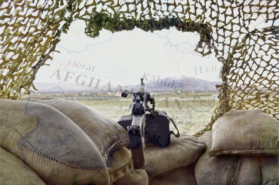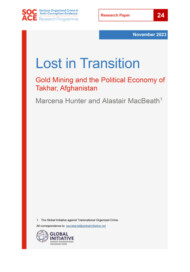Posted on 26 Nov 2025
Sher Mohammed Gul (name changed), a mid-level Balochi Taliban commander based in south-west Afghanistan, needed money. He had weapons to sell: American-made assault rifles, which should have been in high demand. But when he tried to find a buyer, he hit a wall.
The chaotic US withdrawal from Afghanistan in 2021 left the country overflowing with weapons. In the sprawling, contested borderlands of Balochistan, these caches were prized by the Taliban, for their commercial value, and by smugglers, who sold them to the highest bidders among terrorist groups. But the networks that moved arms seamlessly across the mountains were closed to Sher Mohammed Gul. He would have to work hard to establish new contacts in the thriving arms markets that had emerged since the days of insurgency.
Today, in Balochistan, contacts are more important than product. Simply being a member of the Taliban is not enough. Control of checkpoints is lucrative, and only those with the necessary resources, political protection and collusion with officials can transport commodities through the region.
Balochistan stretches across Afghanistan, Iran and Pakistan, at the heart of the Golden Crescent, one of the world’s most infamous drug trafficking hubs. In places where the state provides little support, smuggling is a way of life. The Baloch people, an ethno-linguistic minority, are politically marginalized and economically neglected. To these villagers, country borders are not barriers, but opportunities. Counterfeit goods, diesel, gold and drugs are carried across the rugged terrain, smuggled through gaps in fences and catapulted over them. Large convoys transport illicit freight through official crossings, where contraband is overlooked in exchange for informal ‘taxes’.
This is not a residual economy: it is the prevailing system. The heroin laboratories that flourished during the Mujahadin-era Soviet occupation established the infrastructure of transporters, financiers and corrupt officials that continue to serve today’s illicit markets. Organized criminal networks have established control over key routes and diversified their portfolios, and while they provide livelihoods, they also exert a tight grip on communities through coercion and patronage.
At the same time, the Taliban is working to reshape its global image. Russia became the first country to formally recognize the group in 2025, and China and some Gulf states have accepted its diplomats. Firms from Beijing to Istanbul have struck mineral deals, and Western governments are edging towards pragmatic engagement over issues such as migration, counterterrorism and development aid. The Taliban has proven adept at exploiting the competing agendas of different countries. It has energetically confronted Islamic State – Khorasan Province, while doing little to combat the Tehrik-e-Taliban Pakistan. It is happy to collaborate on counter-narcotics agendas, but continues to profit from the smuggling of heroin and methamphetamine.
The Taliban emphasizes what foreign capitals want to hear, yet it has conceded nothing. There has been no change in the brutal treatment of women and girls, no equality in education and no meaningful action to prevent Afghan soil from being used as a base for terrorism. To some, however, it appears increasingly indispensable in an unstable region – a force for stability they can do business with. To others, like Pakistan, it is an uncontrollable, autocratic regime.
In an attempt to project authority and demonstrate compliance with international norms, the Taliban has clamped down on poppy cultivation, ephedra sales and arms trafficking. But in Balochistan’s borderlands, illicit markets are thriving. High-level traffickers and commanders who are close to the de facto authorities remain untouched, their networks now more concentrated and profitable. Small-scale farmers, smugglers and mid-level commanders have adapted, moving cultivation and processing sites and opening new routes.
And while the Taliban loudly trumpets its war on drugs, the reality is a shift, not an end. The flow of synthetic drugs, heroin and hashish continues. Poppy cultivation has shifted to the north and north-east, or across the border into Pakistan. In 2023, while there was a significant reduction in poppy cultivation in the provinces of Helmand and Kandahar, it persisted elsewhere. The approach is one of selective enforcement, with some markets disrupted and others tolerated.
Crime, conflict and complicity
Balochistan lays bare the gulf between the Taliban’s narrative and the truth, and of the convergence of crime and conflict. Local powerbrokers, including tribal chiefs, Taliban intermediaries and cross-border smugglers, embody a state-backed criminal enterprise, mediating between the state authority of Kandahar and Kabul and local communities to provide control while profiting from criminal markets. The effect is corrosive. Organized crime is no longer a parallel phenomenon to politics – it is politics. Traffickers enjoy protection while communities see their natural resources siphoned off, their labour exploited and their grievances ignored.
For Sher Mohammed Gul, the situation is personal. Once empowered by the insurgency, he now finds himself on the outside looking in, his unsold weapons gathering dust. Unsure if he will retain his job – 30% cuts in the security forces have left many Taliban unemployed – he urgently needs cash. Another option is to invest in a load of opium in Sangin and contract a transporter to smuggle it to Iran. He knows the profit will return within 48 hours. In the grey zone of Balochistan, barriers to enter the drug economy are lower; arms are more sensitive, the preserve of the Kandahar-connected Taliban.
Balochistan’s illicit economies are not an exception; they are the unseen illustration of Taliban rule. Smuggling is tolerated because it stabilizes the fragile bargains between commanders and Kandahar, between elites and communities, and between the Taliban’s external promises and internal dependencies. But the cost is high. State-backed criminality is becoming further entrenched, while ordinary people remain excluded from legitimate opportunities. The situation undermines the Taliban’s claims abroad and creates a nucleus of instability for the future.
Three lessons stand out. First, the Taliban’s narrative of stability is compelling to foreign governments, yet border regions such as Balochistan reveal a different perspective. International actors must resist surface-level assurances of legitimacy. Verification should involve granular monitoring of flows through border markets, triangulating satellite imagery with local field data and consulting communities. Without piercing Kandahar’s facade, external recognition and investment risk reinforcing a system in which illicit economies are quietly tolerated, if not actively encouraged, as a tool of governance.
Second, policymakers must target networks, not commodities. Policies that focus on individual commodities, opium bans, arms seizures or gold licensing consistently punish those at the margins. Farmers, smugglers and minor commanders lose their livelihoods, while traffickers with connections adapt and diversify. Disrupting intermediaries, through financial investigations, cross-border intelligence-sharing and exposure of political protection, would strike at the real architecture of organized crime.
Lastly, as long as Baloch communities are excluded from the revenue generated by their land and denied fair political representation, illicit economies will continue to be their main source of income. International engagement should therefore push for revenue-sharing mechanisms from mining, inclusion in decision-making processes and investment in local services. Supporting alternative economic activities is not just a matter of development policy but of crime prevention. Without structural change, crackdowns will only serve to reinforce the dominance of shadow elites.
Sher Mohammed Gul’s story embodies the inconsistencies of Taliban governance: abroad, the group projects an image of authority and stability; at home, that same authority consolidates illicit markets to generate income for an elite few. This dual nature cannot be sustained indefinitely.
The Taliban claim to have restored security and tough Islamic law in Balochistan, as in the rest of Afghanistan. But trafficking in narcotics and weapons continues unabated, protected by the very men who claim to have restored order. As long as organized crime remains the foundation of economic life in Balochistan, the region will continue to be a mirror of the Taliban’s contradictions. The question is whether the international community will continue to normalize these contradictions.



